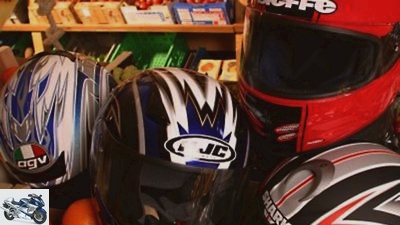Table of contents

Artist
clothing
Helmets
Test new full face helmets
Test new full face helmets
Fresh goods
Now they are back on the shelves: the new full-face helmets for the coming season. Eleven models in the price range around 250 to 300 euros in a practical test.
Holger Hertneck
03/24/2004
For many motorcyclists, the big tingling begins in spring. Does the two-wheeler that has been idle for a few months start on the first try? Is everything ok ?? and clean? Probably the one who cleaned the boots, gloves and leather suit before mothballing and one-
greased or his textile be-
put clothes in the washing machine and then re-impregnated. And if not? Half as wild, then the maintenance aria will be made up at the start of the season. And when it comes to the durability of leather or textile suits, there are none anyway
Misgivings. Leather suits in particular can easily last ten years and more if they are well cared for without falling over.
The matter looks quite different
Helmets off. Apart from cleaning the visor, maintenance is usually limited. Honestly, who washes regularly?
the inner lining, scrubbing the outer shell or storing the helmet from UV rays
protected in darkened, dry rooms? Consequence: the head protection
ages faster than necessary, and the desire for a replacement is growing.
However, you should treat yourself to one after four to five years of helmet use at the latest. Weather, sunlight, sweat, road dust and other external influences when biking
the head protection sooner or later bad
to. Apart from that, they are new
Helmets better than their predecessors in many respects. The fit, ventilation systems, visor technology and aerodynamics are constantly being tinkered with. How well the manufacturers are developing with their current ones
MOTORRAD tested full-face helmets in the upper middle class with base prices of around 250 to 300 euros in an extensive practical test.
The candidates include models from the brands Agv, Bieffe, Held, HJC, Ixs, Kiwi, Nitro, Nolan, Shark, Uvex and Vemar. The RSF 2i from Shark and the Wing III from Uvex were already on the market in the 2003 season, but they have been significantly changed in some points. For example, the RSF 2i has a removable inner lining with an optimized fit and the Wing III has new ventilation-
like redesigned spoilers for improved aerodynamics. All criteria, the function of which MOTORRAD examined more closely in the course of extensive driving tests (see also the Test Criteria box on page 72).
Of course, all test models meet the current ECE standard 22.05. And their requirements are so strict that they do not allow dark-tinted or Pinlock double visors, for example. Almost all helmet manufacturers offer this type of visor as an additional accessory, but without exception the ECE-approved and appropriately marked visor is installed when you buy it. The helmet visors from Ixs, Nitro and Nolan that for that
Assembling the coated Pinlock double disc are prepared to be misted
therefore in the delivery condition. Only after assembly of the insert prevails
A clear view in all weathers, which applies to the other test helmets (with the exception of Bieffe) ex works.
Buy complete article

Test new full face helmets
Fresh goods
6 pages) as PDF
€ 2.00
Buy now
Test: AGV DayStar
Provider: IMAG-Germany, Telephone 07182/805900, www.imag-germany.de
Price: from 249 euros
Sizes: XXS to XXL
Colors: black; Silver;
three decor variants (299 euros)
Weight *: 1440 grams
Practical test
Driving noise:
satisfying
The DayStar is »downstairs«
Despite the wind deflector, it is relatively open and therefore relatively loud
Aerodynamics: good
Lies clean and stable in the wind, no lift noticeable, turning
of the head is possible without great effort
plus
Very easy entry; Anti-fog visor with clean detent;
very easy and quick visor change; smarter,
fold-out wind deflector
on the chin; very good for glasses-
suitable for wearers; Removable inner lining and cheek pads; Reinstallation very easy
minus
Click fastener hooks; except-
the fiddly length adjustment; End of belt not
fixed; Ventilation practical
not noticeable; much too small ventilation switch
Test criteria
The assessment of the helmets is based on the results obtained in the test drives lasting several days and the “dry test”. During the dry test, the entire editorial team was asked for an afternoon to evaluate the fit and ease of use as well as the features and handling of the eleven helmets. The test drives were carried out at three driving speeds (100, 150 and 180 km / h) on a Honda CB 1300.
Driving noise: How quiet or
loud are the helmets when driving? Since the test drives on the same
Motorcycles were carried out with the same head posture and at the same speeds, comparisons can be made very easily.
Aerodynamics: How stable are the helmets in the airstream and how high is the noticeable air resistance? Do the helmets develop buoyancy at certain speeds and how great are the forces when the head is turned??
Practice: It takes up most of the evaluation criteria. The sub-items include entry, fit, pressure points, operating the helmet fastener, fogging tendency of the visor and changing the visor, type, operation and function of ventilation, suitability for people who wear glasses, handling when removing
Cheek pads and inner lining as well as everything else that stands out positively or negatively in daily use of the helmets.
Final scoring
The MOTORRAD rating is calculated from the individual ratings for the criteria of driving noise, aerodynamics and practice. Driving noises and aerodynamics are each weighted once, the practical rating counts three times as it includes a large number of, in some cases very important, sub-items (see also the test criteria box).
The progress of the new helmets, the test results are all quite close together
are mainly reflected in the high-quality equipment and good workmanship. Nevertheless, there is more or less room for improvement in each of the models. The main criticism is the ventilation, which leaves a lot to be desired for most of the candidates. Effective improvements can only be achieved with a high level of development effort-
digit. This also applies to reducing the weight of the helmet and achieving a lower noise level ?? both factors that many motorcyclists would like to see in practice.
Closures
Click locks (regardless of whether they are push-button or slide-button versions) can be closed and opened very quickly and conveniently, but cannot be adjusted while driving. This only works with the helmet off and is usually quite fiddly. If you drive with and without a scarf, you have to readjust the chinstrap length every time.
The light double-D fastener takes a little more time to put on and take off the helmet, but the length of the strap is adapted to the requirements each time and can easily be readjusted while driving. The user-friendly ratchet lock can be opened and closed almost as quickly as a click lock and can be adjusted easily while driving.
Related articles
-
Product test full-face helmets with integrated sun visor
mps photo studio clothing Helmets Product test full-face helmets with integrated sun visor Product test full-face helmets with integrated sun visor…
-
clothing Helmets Test new helmets Test new helmets Good litter? How well have the helmet manufacturers done their models for the 2003 season? MOTORRAD…
-
Helmet test upper class racing helmets
Jahn clothing Helmets Helmet test upper class racing helmets PS helmet test: upper-class racing helmets Top sports helmets in a comparison test Content…
-
Motorcycle helmets: test, purchase advice, ECE standard, communication
Herder 14th pictures Herder 1/14 Jorg Lohse trying in vain to mount a wind deflector on the X-lite. Can you test harder? no! Herder 2/14 The Schuberth S1…
-
Motorcycle helmets made of carbon in the test
Hertneck clothing Helmets Motorcycle helmets made of carbon in the test test Carbon helmets Without coal there is no carbon – this is true at least for…
-
Meyer, BILLION 44 pictures mps 1/44 Many heads, one opinion: fitting problems usually run through many sizes. mps 2/44 Conclusion on the IXS HX 510: A…
-
Product test: full-face helmets for 200 euros
Bilski 17th pictures Bilski 1/17 The chin part of the Scorpion EXO-750 stands out because it can be perfectly adapted to the chin with an air pump and…
-
Flip-up motorcycle helmets between 139 and 649 euros in the test
Photo: mps-Studio 12th pictures mps studio 1/12 12th place: LZR MH2, from 139 euros, 52/100 points, MOTORRAD judgment “sufficient” mps studio 2/12 9th…
-
Comparison test flip-up helmets
Bilski clothing Helmets Comparison test flip-up helmets Comparison test flip-up helmets Open air performance The popularity of flip-up helmets is…
-
Arai Chaser-X Hutchy – Tried full face helmet
Markus Jahn clothing Helmets Arai Chaser-X Hutchy – Tried full face helmet Arai Chaser-X Hutchy Tried full face helmet How does the Arai Chaser-X Hutchy…